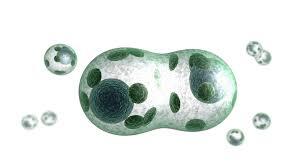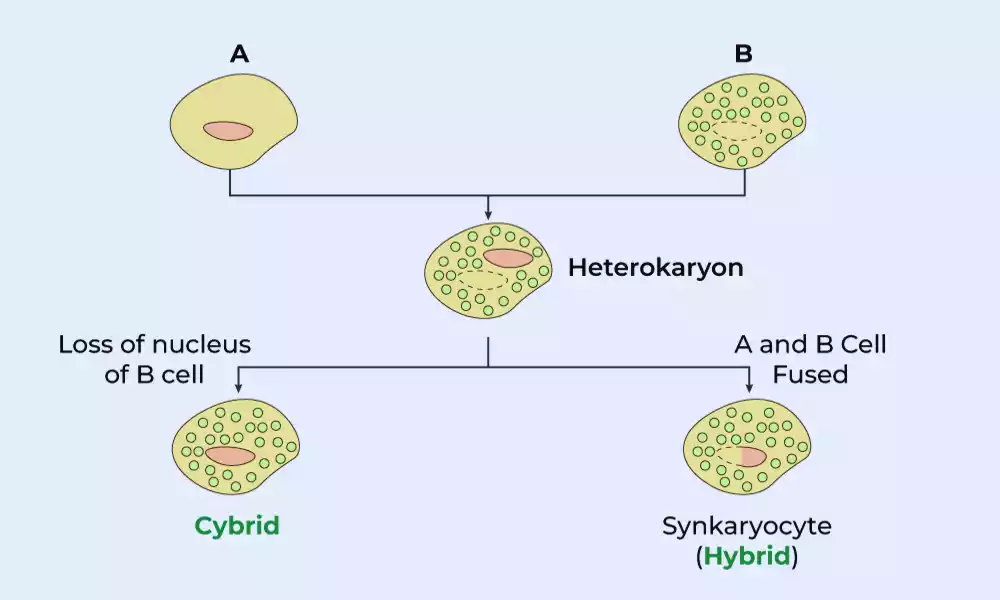Cybrids and Hybrids represent two distinct concepts in biology and biotechnology. Cybrids, short for “cytoplasmic hybrids,” involve the merging of cytoplasmic components from different cells while typically retaining the nucleus of one parent. They are often used in medical and biotechnological research. On the other hand, hybrids refer to organisms resulting from the combination of genetic material from different species, which can occur naturally or artificially.
Hybrids have diverse applications in agriculture, conservation, and breeding programs. Understanding the differences between cybrids and hybrids is crucial for appreciating their respective roles in scientific and practical contexts.
What is a Cybrid?
A cybrid, short for “cytoplasmic hybrid,” is a biological entity created by merging the cytoplasm (the jelly-like substance within a cell that houses various organelles but excluding the nucleus) of one cell with the nucleus of another. Typically, in a cybrid, the nucleus comes from one parent cell, while the cytoplasm is derived from a different cell or source.

This fusion of cellular components can be used in various fields, including medical research and biotechnology, to study specific aspects of cell function, genetics, or to develop new cellular models for research purposes. Cybrids are often employed in areas such as mitochondrial disease research and regenerative medicine.
What is a Hybrid?
A hybrid is an organism or individual resulting from the combination of genetic material from two different species or varieties. Hybrids can occur naturally, such as in the case of crossbreeding between different plant species or animal subspecies, or they can be intentionally created through controlled breeding processes in agriculture and horticulture.

In the context of biology and genetics, hybrids can exhibit a combination of traits from their parent species or varieties, and they may possess unique characteristics that differentiate them from both parental lines. Hybridization is a fundamental concept in biology and is utilized in various fields, including agriculture, conservation, and the development of new plant or animal breeds for specific purposes.
Comparison Table of Cybrids and Hybrids
Here’s a comparison table highlighting the key differences between cybrids and hybrids:
| Aspect | Cybrids | Hybrids |
|---|---|---|
| Definition | Cytoplasmic hybrids, merging the cytoplasm of one cell with the nucleus of another. | Organisms resulting from the combination of genetic material from two different species or varieties. |
| Genetic Composition | Combines cytoplasmic material, often retaining the nucleus of one parent cell. | Combines genetic material from two distinct species or varieties, including both nucleus and cytoplasm. |
| Cellular Components | Cytoplasm from one source, nucleus typically retained from one parent. | Nucleus and cytoplasm from different parent species or varieties. |
| Applications | Commonly used in medical research and biotechnology, especially for studying mitochondria-related diseases and cellular functions. | Applied in agriculture, horticulture, conservation biology, and breeding programs to develop new species or varieties with desired traits. |
| Examples | Creation of cytoplasmic hybrids for mitochondrial research and disease modeling. | Hybridization of different plant species for improved crop yields or the development of animal breeds with specific traits. |
| Ethical Considerations | Ethical concerns often relate to genetic manipulation and potential misuse. | Ethical considerations may include concerns about the impact on biodiversity and potential hybrid sterility. |
| Regulatory Framework | May be subject to specific regulations and ethical guidelines in scientific research. | Subject to regulations and guidelines in agriculture, conservation, and breeding practices. |
| Natural Occurrence | Rarely occurs naturally, primarily a product of laboratory techniques. | Can occur naturally in the wild when species or varieties with compatible genetics crossbreed. |
| Purpose and Focus | Primarily used for scientific inquiry and understanding cellular processes. | Used for practical purposes such as agriculture, conservation, and breeding to achieve desired traits or outcomes. |
| Genetic Diversity | Limited genetic diversity since the nucleus is often retained from one parent. | Potential for increased genetic diversity due to the mixing of genetic material from different species or varieties. |
This table provides a concise overview of the main distinctions between cybrids and hybrids, highlighting their definitions, genetic composition, applications, ethical considerations, and other key factors.
How Cybrids are Created
Cybrids are created through a laboratory-based process that involves the fusion of the cytoplasm from one cell with the nucleus of another. This technique is commonly used in scientific research to study mitochondrial function, investigate mitochondrial diseases, or create cellular models for various purposes. Here’s a step-by-step explanation of how cybrids are typically created:
- Select Parental Cells: The process begins by selecting two types of parental cells. One cell provides the nucleus, which is usually the cell type of interest or relevance to the research. The other cell contributes the cytoplasm, specifically the mitochondria, which are often the primary focus in cybrid creation.
- Isolate Cytoplasm: The cell providing the cytoplasm is typically chosen for its abundant and healthy mitochondria. Researchers then isolate the cytoplasm from this cell. This involves breaking down the cell membrane and removing the nucleus, leaving the mitochondria and other cytoplasmic components intact.
- Prepare Recipient Cells: The recipient cells are typically cells that have had their nucleus removed or inactivated, rendering them incapable of normal cellular function. This step ensures that the nucleus from the donor cell will be the primary genetic material in the resulting cybrid.
- Fusion of Cytoplasm and Recipient Cells: The isolated cytoplasm containing healthy mitochondria is then fused with the prepared recipient cells. This fusion can be achieved using various techniques, such as chemical agents, electrical pulses, or specialized fusion proteins. The goal is to merge the cytoplasmic content of the donor cell with the nucleus-depleted recipient cell.
- Cell Culture and Selection: After fusion, the resulting cybrids are cultured in a suitable growth medium. Researchers often use selective culture conditions that favor the survival and proliferation of the cybrids while suppressing the growth of any remaining non-fused cells.
- Analysis and Research: Cybrids can now be studied for various purposes. Researchers can investigate mitochondrial function, assess the impact of specific genetic mutations in the nucleus on mitochondrial health, or use cybrids as cellular models for understanding and potentially treating mitochondrial diseases.
The creation of cybrids involves meticulous laboratory techniques and is typically carried out in a controlled environment. Ethical considerations and guidelines are also important when working with cybrids, especially in cases where the research involves human cells or has implications for reproductive medicine.
How Hybrids are Formed
Hybrids are formed through the process of hybridization, which involves the mating or crossbreeding of two individuals from different species or varieties. The specific method of hybridization can vary depending on the organisms involved, but the fundamental process generally follows these steps:
- Selection of Parental Organisms: Two parent organisms from different species or varieties are selected for hybridization. These parent organisms may have desirable traits that researchers or breeders want to combine in the resulting hybrid.
- Cross-Pollination (Plants) or Mating (Animals): The method of hybridization depends on whether the organisms are plants or animals.
- In Plants: For plant hybridization, the process typically involves cross-pollination, where pollen from the male reproductive organ (stamen) of one plant is transferred to the female reproductive organ (pistil) of another plant. This can be done manually by plant breeders or naturally through wind or insect pollination.
- In Animals: For animals, hybridization generally involves mating two individuals of different species or subspecies. In some cases, artificial insemination or controlled breeding techniques may be used to facilitate the mating.
- Fertilization: After pollination or mating, fertilization occurs. This is the process where the male gametes (sperm) from one parent combine with the female gametes (eggs) from the other parent, leading to the formation of a hybrid zygote.
- Development: The hybrid zygote develops into an organism over time. The resulting hybrid offspring will typically inherit a combination of genetic traits from both parental species or varieties.
- Traits of the Hybrid: The traits of the hybrid offspring can vary widely depending on the genetic makeup of the parent organisms. Hybrids may exhibit a mix of characteristics from both parental species, and sometimes they may possess unique traits not present in either parent.
- Propagation or Observation: Depending on the purpose of hybridization (e.g., agriculture, conservation, or scientific study), the hybrid offspring may be propagated to create more individuals with the desired traits or observed to study their characteristics and behavior.
All attempts at hybridization are successful, as the genetic compatibility between species or varieties can vary. Some hybrids may be sterile and unable to reproduce, while others may thrive and become established as distinct hybrid populations. The creation and study of hybrids play important roles in various fields, such as agriculture, horticulture, conservation, and evolutionary biology.
Benefits of Cybrids and Hybrids
Cybrids and hybrids offer various benefits, and their advantages can be significant in different fields and applications. Here are some of the key benefits of cybrids and hybrids:
Benefits of Cybrids:
- Mitochondrial Research: Cybrids are valuable tools for studying mitochondrial function and diseases. Researchers can introduce specific mitochondrial DNA mutations into cybrids to better understand the role of mitochondria in health and disease.
- Cellular Models: Cybrids provide researchers with cellular models to investigate the effects of nuclear and mitochondrial interactions. This is crucial for studying various diseases, including neurodegenerative disorders and metabolic diseases.
- Drug Development: Cybrids can be used to screen and test potential drugs for mitochondrial diseases and other conditions related to mitochondrial dysfunction. This can accelerate drug development processes.
- Reproductive Medicine: Cybrid technology has been explored for its potential in addressing issues of infertility and preventing the transmission of mitochondrial diseases from mother to child. Techniques like mitochondrial replacement therapy (MRT) involve the use of cybrids.
- Understanding Genetic Inheritance: By creating cybrids with specific genetic mutations, scientists can gain insights into how mutations in the mitochondrial DNA or nuclear DNA are inherited and impact an individual’s health.
Benefits of Hybrids:
- Crop Improvement: Hybrids are extensively used in agriculture to develop crop varieties with enhanced characteristics such as higher yields, disease resistance, or improved nutritional content. Hybridization can lead to better agricultural productivity.
- Genetic Diversity: Hybridization can increase genetic diversity within a population. This can be important for the adaptation of species to changing environmental conditions and can help prevent inbreeding depression.
- Conservation: In some cases, hybridization can aid in the conservation of endangered species by introducing genetic diversity and increasing the fitness of the population.
- Horticulture: In horticulture, hybridization is used to create ornamental plants and flowers with unique colors, shapes, and sizes, appealing to consumers and contributing to the horticultural industry.
- Animal Breeding: Hybridization can be employed in animal breeding programs to develop new breeds or varieties with desirable traits, such as increased milk production in dairy cattle or improved meat quality in poultry.
- Scientific Study: Hybrid organisms are often studied to gain insights into the genetic basis of traits, speciation, and evolutionary processes. They provide valuable information about how genes interact in different genetic backgrounds.
- Species Evolution: In some cases, hybridization can lead to the formation of new species, contributing to the diversity of life on Earth through the process of speciation.
Cybrids and hybrids serve distinct purposes in scientific research, agriculture, conservation, and breeding programs. Their benefits range from advancing our understanding of cellular processes to improving food production, enhancing genetic diversity, and contributing to the conservation and evolution of species.
Ethical Concerns and Potential Drawbacks
While cybrids and hybrids offer numerous benefits in various fields of science and agriculture, they also raise ethical concerns and potential drawbacks that must be carefully considered. Here are some of the ethical concerns and drawbacks associated with these technologies:
Ethical Concerns Regarding Cybrids:
- Genetic Manipulation: The creation of cybrids often involves genetic manipulation, which raises ethical questions about the alteration of genetic material, particularly in the context of human cybrids. Concerns include unintended consequences, safety issues, and long-term effects.
- Reproductive Medicine: In the case of human cybrids and mitochondrial replacement therapies, ethical concerns relate to the potential implications for future generations. Altering mitochondrial DNA could have unforeseen consequences for offspring.
- Informed Consent: In medical research involving cybrids, obtaining informed consent from donors of genetic material (e.g., eggs or embryos) is crucial. Ensuring that individuals fully understand the implications of their contribution is an ethical challenge.
- Species Boundaries: Cybrids, especially those involving different species, blur the boundaries between species, which can challenge traditional definitions and concepts of species in biology.
- Privacy and Ownership: Questions regarding the ownership and control of the resulting cybrids’ genetic material and data can raise ethical issues, particularly in commercial and research contexts.
Ethical Concerns and Potential Drawbacks Regarding Hybrids:
- Impact on Biodiversity: Hybridization between closely related species can lead to the homogenization of gene pools and the loss of distinct species. This can have negative consequences for biodiversity and ecosystem stability.
- Invasive Hybrids: In some cases, hybridization can result in the creation of invasive hybrid species that outcompete native species and disrupt ecosystems. This is a concern in conservation biology.
- Ethical Treatment of Hybrids: Ethical considerations arise regarding the treatment and conservation efforts for hybrids, especially when they have characteristics of both parental species. Deciding whether to protect hybrids as a distinct entity or as part of a conservation strategy can be complex.
- Genetic Integrity: In agriculture, hybrid crops may require continuous human intervention and seed purchases because they do not reproduce true to type. This can raise concerns about the dependence of farmers on seed companies and the genetic integrity of food crops.
- Unpredictable Traits: Hybrid offspring may exhibit unpredictable traits and behaviors, making them challenging to manage or breed for specific purposes.
- Crossbreeding Risks: When creating hybrids, there is a risk of introducing undesirable traits or vulnerabilities from one parent species to another. For example, hybrid diseases or reduced fitness.
- Ethical Treatment of Parental Species: The process of hybridization can sometimes result in the displacement or decline of parental species. Ethical considerations come into play regarding the conservation and protection of these parent species.
- Loss of Cultural Identity: In some cases, hybridization can affect culturally significant or symbolic species, raising ethical concerns about the preservation of cultural and traditional values.
In both cases, careful consideration of ethical principles, transparency, regulatory oversight, and responsible use of these technologies are essential to mitigate potential drawbacks and ensure that the benefits of cybrids and hybrids are balanced with ethical and environmental considerations.
Cybrids, Hybrids, and the Future
The future of cybrids and hybrids holds promise and presents both challenges and opportunities across various scientific, medical, agricultural, and conservation domains. Here’s a glimpse into what the future might hold for these technologies:
Cybrids:
- Advancements in Mitochondrial Research: Cybrids will continue to be valuable tools for advancing our understanding of mitochondrial function and genetics. Future research may lead to breakthroughs in treating mitochondrial diseases and improving overall health.
- Reproductive Medicine: The use of cybrids in reproductive medicine, such as mitochondrial replacement therapy (MRT), may become more refined and widely accepted. This could potentially reduce the transmission of mitochondrial diseases from one generation to the next.
- Drug Development: Cybrids will play a vital role in drug development for mitochondrial disorders and other diseases associated with mitochondrial dysfunction. Tailored therapies and targeted drug treatments may emerge.
- Ethical and Regulatory Frameworks: As the use of cybrids grows, ethical and regulatory frameworks will evolve to address emerging concerns regarding genetic manipulation, privacy, and ownership of genetic material.
- Stem Cell Research: Cybrids will continue to be instrumental in stem cell research, particularly in studying pluripotent stem cells and their potential applications in regenerative medicine.
Hybrids:
- Agriculture and Food Security: Hybrids will remain critical in agriculture for improving crop yields, disease resistance, and nutritional content. The development of climate-resilient hybrid crops may become essential for food security in a changing climate.
- Conservation Biology: Hybrids may be strategically used in conservation efforts to restore genetic diversity and adaptability in endangered species. Conservationists will need to carefully consider the role of hybrids in ecosystem management.
- Invasive Species Management: The management and control of invasive hybrid species will become a growing challenge. Strategies to mitigate the negative impacts of invasive hybrids on ecosystems will be developed.
- Genomic Selection: Advances in genomics will enhance our ability to predict the outcomes of hybridization and selectively breed individuals with desired traits. This precision breeding can revolutionize agriculture and conservation.
- Biotechnology and Synthetic Biology: Hybrids may be engineered for specific purposes, such as the creation of biofuel-producing organisms or organisms with enhanced environmental remediation capabilities.
- Ethical Considerations: Ethical considerations surrounding hybrids will become more complex as hybridization occurs naturally and artificially in various contexts. Balancing the preservation of biodiversity with the potential consequences of hybridization will remain a central challenge.
The responsible use of both cybrids and hybrids will rely on advancements in science, robust ethical guidelines, and careful consideration of their implications. These technologies have the potential to address pressing challenges in health, agriculture, conservation, and beyond, but their development and application should always prioritize safety, ethics, and environmental sustainability.
Conclusion
Cybrids and Hybrids represent two distinct yet impactful frontiers in the realms of biology, genetics, and agriculture. Cybrids offer a window into the intricate workings of cellular biology and hold great potential for advancing our understanding of mitochondria and related diseases. Meanwhile, hybrids play pivotal roles in agriculture, conservation, and evolutionary studies, offering opportunities to improve crop yields, restore biodiversity, and shed light on the dynamics of genetic diversity.
Ethical concerns and environmental implications must be navigated carefully as these technologies continue to evolve. The future of cybrids and hybrids is poised to bring both profound insights and significant challenges as we harness their potential for the betterment of science, medicine, and the natural world.































